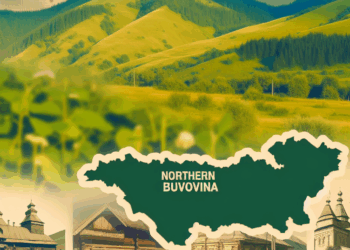Introduction
Bukovyna is one of the most vibrant and diverse regions of Ukraine, with a rich history that dates back centuries. Influenced by Ukrainian, Romanian, Jewish and Polish cultures, this region has become home to a multitude of traditions, customs and unique artistic expressions. In this article, we will take a closer look at understanding the cultural heritage of Bukovina, with a focus on traditions, folk costumes, crafts, festivals and music.
Traditions
Bukovina is famous for its traditions, which are carefully handed down from generation to generation. Regional holidays, rites and rituals reflect the diversity of ethnic and cultural influences. One of the most famous rites is “Kolyada”, which takes place in winter and symbolises saying goodbye to the old year and welcoming the new one.
Also important is the holiday “Ivana Kupala”, which is celebrated on the night of 6-7 July. This holiday is connected with ancient pagan beliefs and is associated with the summer solstice. On this day, purification rituals are performed and festivities dedicated to love and fertility are organised.
Folk Costumes
Folk costumes of Bukovina are diverse and unique, which is explained by the multinational history of the region. The Ukrainian part of Bukovina is characterised by embroidered shirts, long skirts and shawls. Men’s clothing often consists of trousers, typical “zhupanivs” and embroidered shirts.
The Romanian element is evident in women’s costumes, which include full-length skirts with colourful patterns and undergarments with intricate embroidery. The Jewish community has also left its mark on traditional dress, represented by dark, austere garments and headdresses.
An important role in the cultural heritage of Bukovina is played by table of contents and accessories, such as waist belts and embroidered shawls, which were characteristic of different ethnic groups, mentioning different embroidery techniques and materials.
Crafts
Handicrafts in Bukovina have a rich tradition, with centuries of development under the influence of different cultures. One of the most famous is weaving. Weaving masters in villages such as Verkhovyna and Kuti create not only traditional embroideries, but also artistic fabrics with unique ornaments.
Ceramics also occupies a special place in the region’s crafts. Potters from the village of Prutulec create unique ceramic products, which are considered real works of art. Their products are decorated with cheerful patterns and are known for their quality.
In addition, wood carving is developed in Bukovina. Masters from Boyarka village create unique elements of decoration for houses and temples, bringing an element of creativity into every detail.
Holidays
Bukovina is not only diverse in its cultural heritage, but also in its festivals, which are an important part of local life. Some of the most colourful holidays are:
-
- Village Day – which is celebrated in most local communities. This event is usually accompanied by fairs, exhibitions of folk crafts, concerts and sports competitions.
-
- Bukovyna Spring Festival – which takes place in Chernivtsi and attracts participants from all corners of the region. This festival brings together music, dance, culinary traditions and art, emphasising the diversity of cultural life in Bukovyna.
-
- Harvest Festival – every village celebrates the harvest season with generous treats and local musical performances. It is a time of unity and gratitude to nature.
Music
The musical culture of Bukovina is a unique fusion of different traditions. Ukrainian folk melodies, Romanian tunes, Jewish and Polish motifs can be heard in the regions folk music. Traditional musical instruments include the bandura, domra and clarinet, which are often used in ensembles.
An important event in the musical life of the region is the Folk Music Festival. Popular, this festival attracts many performers and listeners, introducing them to the cultural heritage of Bukovina. Local ensembles give the audience the opportunity to hear traditional melodies as well as modern arrangements of folk songs.
Folklore
The folklore heritage of Bukovina is inexhaustible and includes fairy tales, legends, proverbs and omens, which have deep roots in the life of local people. Many of them are based on historical events or folk beliefs.
Tales of “Semargle”, a spirit guarding forests and fields, or of “Mavka”, a beautiful but evil forest soul, are popular in the oral tradition. These stories, passed on by word of mouth, convey moral values and include elements of deep folk wisdom.
Each village has its own unique legends and images related to local history, about the struggle for freedom and independence, full of symbolism and metaphors, sometimes overlapping with historical realities.
Multinational Heritage
The uniqueness of Bukovina lies in its multinational heritage. Historically, the region has been an area of pronounced multiculturalism, which is expressed in customs, language, cuisine, etc. Numerous ethnic groups have influenced the formation of Bukovinian culture.
The influence of Ukrainian culture is quite evident in folk dances and songs, while the Romanian tradition is represented in folklore and festivals. The Jewish cultural community, which had a rich history in the region, made a significant contribution by preserving unique traditions and language.
Polish culture made its mark in architecture and painting, as well as in the tradition of corn festivals and cookery. This diversity of cultures has created a unique ambient where locals are proud of their diversity and cultural heritage.
Conclusion
Bukovina is not just a geographical region, but a cultural phenomenon that epitomises the harmonious coexistence of many ethnic groups. Its self has managed to preserve the diversity of cultural traditions, folklore, crafts and festivals. It is necessary to remember the importance of preserving this heritage, which serves as a link for the inhabitants of the region, creating a unique identity and the multifaceted nature of its culture.
Bukovina remains an exciting and wonderful place, where every tradition and holiday is filled with deep significance and history, preserving the spirit of a multinational people, influenced by many cultures.








